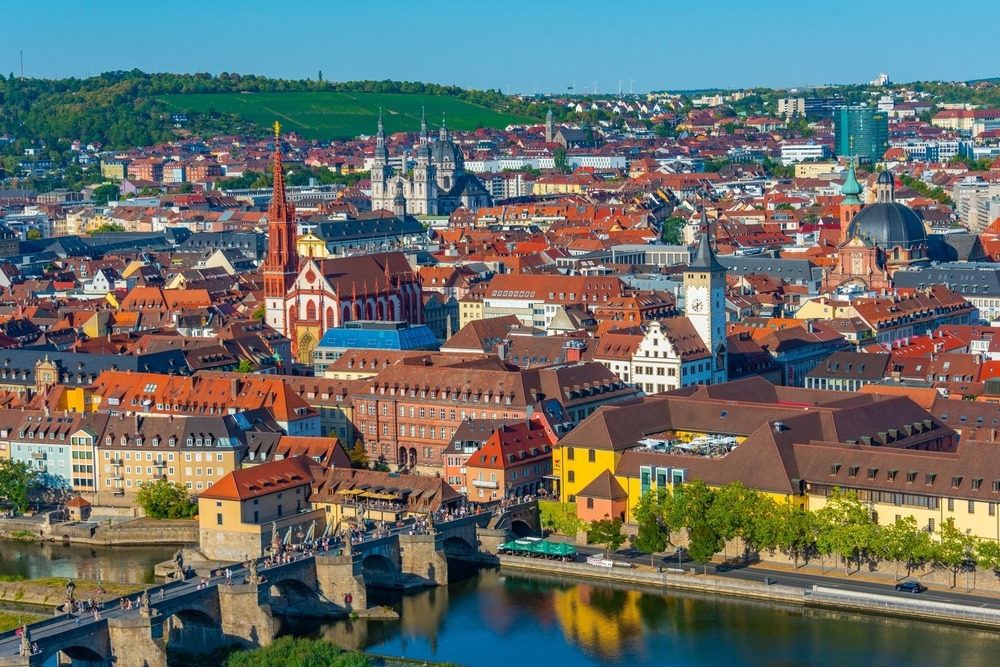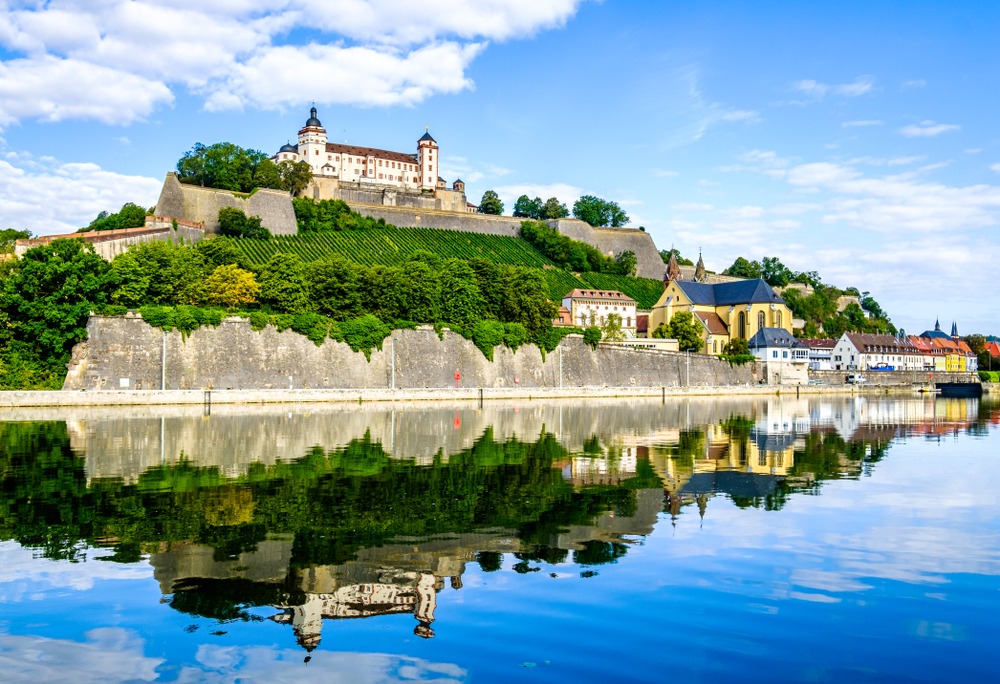Würzburg, Germany: Where Baroque Grandeur Meets Ancient Heritage
History of Würzburg
Würzburg, located on the banks of the Main River in northern Bavaria, is a city rich in history, culture, and architectural splendor. Its origins trace back over 3,000 years, with early Celtic settlements in the region. By the 7th century, Würzburg had become an important Frankish stronghold and a center of Christian missionary activity. The city gained ecclesiastical prominence in 742 AD when Saint Boniface established the Diocese of Würzburg, appointing Saint Burchard as its first bishop.
During the Middle Ages, Würzburg evolved into a spiritual and administrative powerhouse under the rule of the Prince-Bishops, ecclesiastical rulers who wielded both religious and secular power. Their influence reached its zenith in the Baroque period, reflected in the construction of the Würzburg Residence, a UNESCO World Heritage Site that stands as one of the most magnificent Baroque palaces in Europe.
The city also became a cultural and academic hub, home to the Julius-Maximilians University, founded in 1402, making it one of the oldest universities in Germany. Over the centuries, Würzburg witnessed religious conflicts, economic upheavals, and cultural rebirths. Tragically, on March 16, 1945, near the end of World War II, an Allied bombing raid destroyed nearly 90% of the city’s historic core in just 17 minutes. Yet Würzburg rose from the ashes, undergoing decades of careful restoration that brought its treasured architecture and spirit back to life.
Today, Würzburg is a vibrant blend of historical reverence and modern living. With its prestigious wine culture, stunning riverfront, and artistic heritage, it draws visitors seeking both scenic beauty and a deeper connection to Germany’s storied past.

Top 25 Attractions in Würzburg
-
Würzburg Residence (Würzburger Residenz)
A masterpiece of Baroque architecture, this UNESCO-listed palace features the grand staircase, the world-famous ceiling fresco by Tiepolo, and opulent staterooms that showcase 18th-century elegance. -
Residence Court Gardens (Hofgarten)
Beautifully manicured Baroque gardens behind the Würzburg Residence, offering fountains, statues, floral displays, and peaceful walking paths. -
Marienberg Fortress (Festung Marienberg)
Perched high above the city, this fortress offers panoramic views of the Main River valley and houses museums showcasing the region’s military and cultural history. -
Old Main Bridge (Alte Mainbrücke)
Lined with stone statues of saints, this 15th-century bridge offers iconic views of the city, often enjoyed with a local glass of Franconian wine in hand. -
Würzburg Cathedral (St. Kilian’s Cathedral)
One of Germany’s largest Romanesque churches, this 11th-century cathedral is the resting place of many Prince-Bishops and features impressive baroque and gothic elements. -
Neumünster Church
Known for its red façade and fusion of Romanesque and Baroque architecture, this church is also the burial site of Saint Kilian, the city’s patron saint. -
Juliusspital and Wine Cellars
A unique combination of hospital, baroque architecture, and wine estate, the Juliusspital is also home to one of Germany’s largest and most historic wine cellars. -
Market Square (Marktplatz)
The city’s lively central square, hosting farmers’ markets and seasonal festivals, is surrounded by historic buildings and cafés perfect for people-watching. -
St. Mary’s Chapel (Marienkapelle)
A striking example of Gothic architecture, this red-sandstone church on the market square stands on the site of a medieval pogrom and now memorializes Würzburg’s Jewish history. -
Museum am Dom
A cultural treasure trove located next to the cathedral, this museum features religious art from the Middle Ages to the modern era, including works by renowned German artists. -
Käppele Pilgrimage Church
Located on a hill above the Main, this Rococo gem offers ornate interiors and sweeping views of Würzburg and the surrounding vineyards. -
Würzburg State Gallery (Staatliche Kunstsammlungen)
Located within the Marienberg Fortress, the gallery showcases Franconian art from the Middle Ages through the Baroque period, including works by Tilman Riemenschneider. -
Botanical Garden of the University of Würzburg
A peaceful retreat with themed gardens, greenhouses, and educational exhibits, this botanical garden supports research and public enjoyment. -
Juliusspital Courtyard
The central courtyard of the historic Juliusspital offers a quiet spot surrounded by beautiful Baroque buildings and vine-covered walls. -
Mainfränkisches Museum
Located in Marienberg Fortress, this museum explores Franconian history with exhibits ranging from archeology to Baroque sculpture and folk traditions. -
Röntgen Memorial Site
Würzburg was where Wilhelm Conrad Röntgen discovered X-rays in 1895. This memorial honors his pioneering work in physics and medical science. -
Congress Centrum Würzburg
A modern riverside venue that hosts events and performances, offering scenic views and a contrast to the city’s historic character. -
Falkenhaus
This Rococo building near the Marienkapelle features ornate stucco work and currently houses the city library and tourist information center. -
Würzburg University (Julius-Maximilians-Universität)
One of Germany’s oldest and most respected universities, the campus includes historic halls and monuments to distinguished scholars. -
Würzburg Wine Village (Weindorf)
An annual event held in early summer at the market square, offering a chance to taste regional wines and local Franconian cuisine. -
Civic Art Gallery Würzburg (Kulturspeicher)
Located in a former granary by the river, this contemporary art museum presents modern and 20th-century European art in a minimalist, industrial setting. -
St. Burkard Church
One of the oldest churches in Würzburg, located just below the Marienberg Fortress, it features Romanesque architecture and peaceful cloisters. -
Würzburg Harbor Promenade
A modern riverside walk that provides a pleasant contrast to the city’s historic areas, with paths for cycling and strolling along the Main. -
Ringpark
A lush greenbelt that encircles the city center, this park is ideal for walking, jogging, or simply relaxing among sculptures and flower beds. -
Franconian Wine Country Tours
Würzburg is the gateway to the Franconian Wine Country. Local tours depart from the city, winding through nearby vineyards and wine-producing villages like Sommerach and Volkach.

Würzburg is a city where the grandeur of the past meets the vibrancy of today. With its palatial architecture, ecclesiastical landmarks, hilltop fortresses, and a wine tradition that predates modern Europe, the city offers an enchanting experience for travelers. Whether you’re marveling at Tiepolo’s frescoes, sipping Silvaner by the river, or exploring medieval bastions, Würzburg delivers a deep and rewarding journey through German heritage and culture.

































